Navigating the complex world of chemical safety can be daunting, especially when every region has its own set of rules and symbols. Enter GHS, an internationally recognized system created to bring coherence to the classification and labeling of hazardous substances. But what does GHS stand for, and why should it matter to you?
In this blog, we’ll demystify the meaning of GHS, delve into its distinctive symbols, and explore its vital classifications. Whether you’re a professional in the chemical industry, an academic researcher, or just someone keen on understanding global safety standards, this guide is tailored for you. Dive in and uncover the essence of GHS – a system shaping how we perceive and handle chemicals in today’s interconnected world.
What Does GHS Stand For? Definition
GHS stands for the Globally Harmonized System of Classification and Labelling of Chemicals. It’s a universal and international standard developed by the United Nations to unify and standardize chemical hazard classification, labeling, and communication worldwide. The primary aim of the GHS is to ensure that information regarding the dangers of chemicals is available and understood by anyone, anywhere, thereby promoting safety, reducing risks, and simplifying international trade in chemicals.
Reasons for GHS Development
GHS was developed to address the challenges of various classification and labeling systems worldwide. Such disparities made it expensive and challenging for governments to regulate, increased costs for industries dealing with different regulations, and often resulted in confusion for workers trying to understand the hazards associated with chemicals.
A unified system, as represented by GHS, aids in regulatory efficiency, promotes safer handling and use of chemicals, eases compliance, and offers consistent hazard information.
GHS Symbols
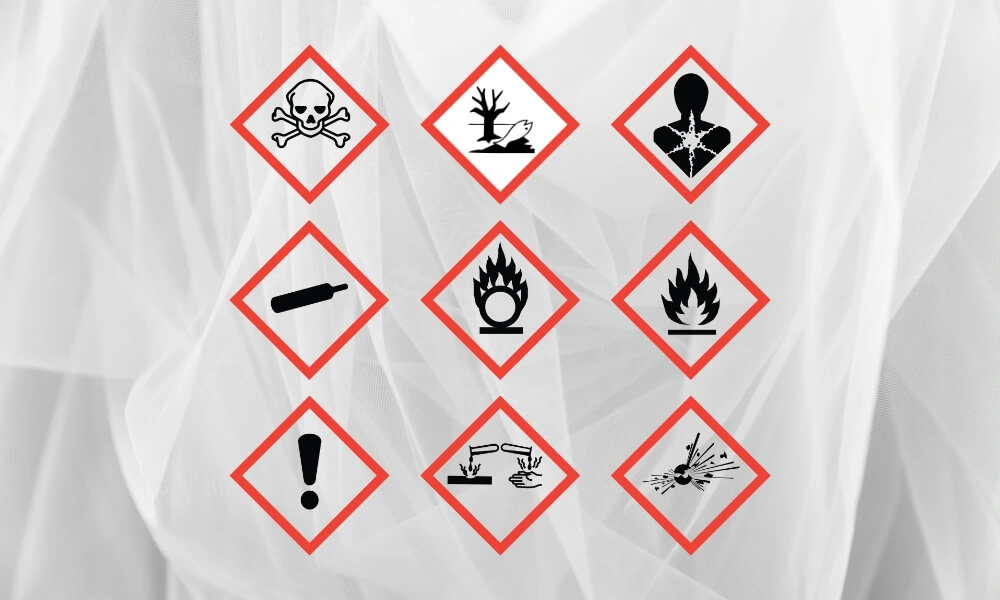
GHS symbols, also known as pictograms, are graphic images that visually represent specific hazard classes and categories. These pictograms are integral to the GHS system, ensuring that chemical hazards are universally understood regardless of language or literacy barriers. Each pictogram has a black symbol on a white background, enclosed by a red diamond-shaped border.
Here are the primary GHS pictograms and a brief description of each:
- Explosive: Depicts an explosion with a burst of fragments. This symbol represents chemicals that are explosives, self-reactive, or organic peroxides.
- Flame: Shows a simple flame. It’s used for flammable chemicals, self-reactive, pyrophoric, self-heating chemicals, and emitting flammable gases in contact with water.
- Flame Over Circle: A flame atop a circle. This represents oxidizing gases, liquids, and solids.
- Gas Cylinder: Features a gas cylinder. It’s used for gases under pressure.
- Corrosion: Depicts a substance corroding a metal and a hand. It represents corrosive substances that can damage metal and cause skin burns.
- Skull and Crossbones: As the name suggests, it symbolizes a skull with two crossed bones behind it. This symbolizes acute toxicity.
- Health Hazard: Shows a person’s chest with a star-like figure over it. It represents various health hazards, including respiratory sensitizers, carcinogens, reproductive toxicants, and others that target specific organs.
- Exclamation Mark: A simple exclamation point. It’s used for several hazards, including skin and eye irritants and acute toxicity (for less toxic substances).
- Environmental Hazard: Depicts a dead tree and fish. It represents chemicals hazardous to the aquatic environment.
- Biohazard: (Though not a part of the core GHS pictograms, it’s sometimes used in conjunction with them.) Features the three-curved segments forming a circle, representing biohazardous substances.
Each of these symbols provides a quick visual cue about the nature of the hazard presented by a substance, mixture, or article. Workers, transporters, emergency responders, and consumers must familiarize themselves with these symbols to ensure chemicals safe handling and use.
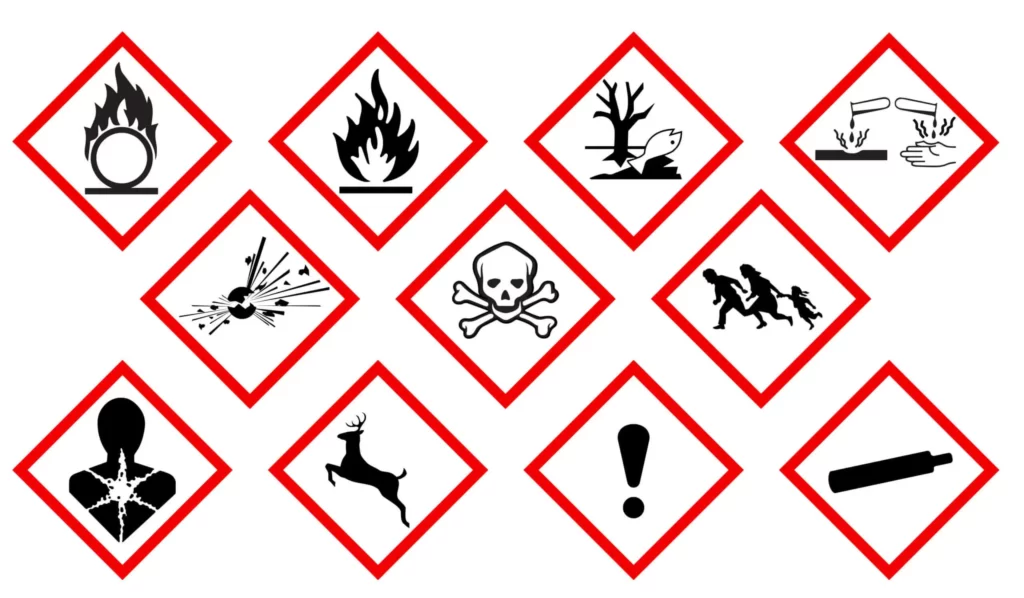
GHS Key Components and Meanings
The Globally Harmonized System (GHS) uses standardized elements to communicate the hazards of chemicals. These elements include:
1. Globally Harmonized
“Globally Harmonized” reflects a vast international endeavor to streamline and integrate chemical safety regulations worldwide. Instead of multiple countries and regions having distinct, sometimes conflicting, criteria and definitions for chemical hazards, the GHS aims for universality. This collective effort is not merely idealistic; it addresses real-world implications. International trade involves the transport of vast amounts of chemicals across borders.
Without a harmonized system, a chemical considered safe in one country might be deemed hazardous in another, creating confusion, potential safety risks, and trade barriers. The GHS serves as a bridge, harmonizing these differences and ensuring consistent global understanding and management of chemical hazards.
2. Classification
The heart of the GHS is its methodology for classification. Instead of every country or region relying on its own criteria for what constitutes a hazard, the GHS provides a meticulous, systematic approach to evaluating chemicals. This classification considers various aspects of potential harm. Physical hazards relate to the inherent properties of the chemical that might pose dangers, such as its combustibility, potential to explode, or reactivity with other substances.
Health hazards, on the other hand, pertain to the potential of a chemical to cause harm to the human body, which can range from skin irritations to more serious implications like carcinogenicity. Meanwhile, environmental hazards take a broader view, assessing how a chemical might harm the surrounding ecosystem, affecting aquatic life or contributing to larger issues like ozone layer depletion.
3. Labeling
Classifying chemicals is important to communicate these hazards effectively to those who handle, transport, or use them. The GHS introduces a unified system of labeling that encapsulates the identified hazards. Unlike earlier systems where symbols or terms might vary widely, under the GHS, specific symbols, called pictograms, are universally recognized.
A flame, for instance, unambiguously indicates flammability. Similarly, signal words like “Warning” or “Danger” provide a quick assessment of the severity of the hazard. Complementing these are hazard statements, which concisely describe the nature and degree of risk. The goal of this standardized labeling system is clarity. Whether a worker in Asia or a scientist in Europe encounters a chemical, the label should immediately and unequivocally convey its potential dangers.
4. Chemicals
At the crux of the GHS is its broad applicability to a diverse array of substances. The term “chemicals” in the context of the GHS is expansive. It doesn’t just refer to individual, isolated compounds but extends to mixtures of chemicals as well. Furthermore, it’s not limited to raw, unprocessed substances. Refined products, which might be used in industries or household products, also fall under the GHS’s purview.
An important note is that the system also considers articles and objects that might release chemicals under certain conditions. This comprehensive coverage ensures that whether it’s a raw material being transported for industrial use or a finished product on a store shelf, the potential hazards associated with any chemicals involved are consistently and clearly communicated.
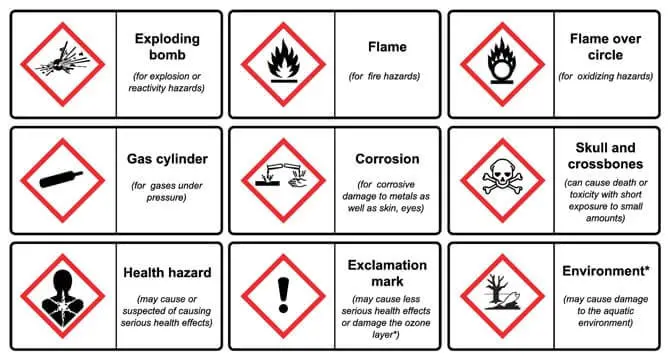
Benefits of Globally Harmonized System (GHS)
The Globally Harmonized System (GHS) is an internationally agreed-upon system for the classification and labeling of chemicals. It was developed by the United Nations to provide a standardized approach to communicating information about hazardous chemicals across borders. The GHS has several benefits, including:
1. Promotes Regulatory Efficiency
One of the primary benefits of GHS is the enhanced regulatory efficiency it brings. Before adopting this harmonized system, governments worldwide were burdened with the intricate task of understanding, evaluating, and then reconciling multiple chemical classification systems.
With the introduction of GHS, there’s now a universal framework, making it easier for governments to set regulations, monitor compliance, and ensure the safety of their citizens without being entangled in a web of varying standards. This uniformity helps streamline administrative processes and ensures more effective enforcement.
2. Facilitates Trade
Chemicals are traded across borders more frequently than ever in our globalized world. The presence of multiple classification systems is used to pose significant trade barriers. Differing standards and classifications could result in customs delays, increased inspections, or outright bans.
With GHS, these barriers are substantially reduced. Since there’s a common understanding of the hazards and classifications, countries can trust the safety evaluations done by others, making the import and export of chemicals smoother and more predictable.
3. Eases Compliance
Adhering to varying regulations was a complex and resource-intensive task for industries operating in multiple countries. Multiple systems meant multiple sets of documentation, training, and labeling standards. With the GHS, companies can standardize their hazard communication processes, making ensuring compliance across the board easier. This also means a significant reduction in non-compliance’s legal and financial risks.
4. Reduces Costs
Standardization inherently brings about cost reductions. This translates to savings for companies like labeling production, employee training, and information management. Businesses can realize significant cost efficiencies without the need to produce different labels for different markets or provide varied training for employees in different countries.
5. Consistent Hazard Information
Safety is paramount when dealing with chemicals. GHS ensures that no matter where a worker or consumer encounters a chemical, they’re presented with consistent, standardized hazard information. This global consistency means a user in one part of the world is as informed and protected as elsewhere, substantially reducing the risk of mishandling or misinterpretation.
6. Safe Transport, Handling, and Use
GHS’s standardized labels and safety data sheets are designed to be clear and easily understandable. Whether it’s a truck driver transporting chemicals, a warehouse worker handling them, or a lab technician using them, the harmonized system ensures everyone has the knowledge they need to do so safely. This reduces the likelihood of accidents or exposure.
7. Emergency Response
In the unfortunate event of a chemical incident, first responders need immediate and clear information to effectively manage the situation. With GHS, emergency personnel can be assured that the hazard information they access is consistent with global standards. This ensures a quicker, more effective response, potentially saving lives and reducing environmental impact.
8. Animal Testing
One of the less obvious but highly significant benefits of GHS is its potential to reduce the need for animal testing. Since the system harmonizes test methods and criteria, tests conducted in one country can be accepted in another without the need for repetition. This reduces the costs associated with redundant testing and the ethical concerns and actual usage of animals in laboratory tests.
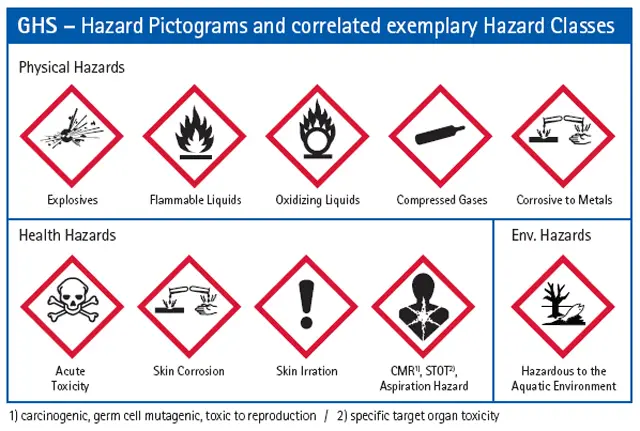
Essential Requirements For GHS Labels & Signs
GHS labels and signs are crucial tools for communicating chemical hazards. They are designed to be immediately recognizable and understandable to ensure safety in handling, transporting, and using chemicals. Here are the essential requirements for GHS labels and signs:
- Product Identifier: This refers to the name or number used for a hazardous product on a label or in the SDS (Safety Data Sheet). It allows users to cross-reference the label and the SDS for comprehensive information.
- Supplier Identifier: This includes the manufacturer’s or distributor’s name, address, and telephone number. This information is crucial should there be a need for more detailed information or in case of an emergency related to the product.
- Signal Words: There are two signal words in the GHS system: “Warning” and “Danger.” “Danger” is used for the more severe hazards, while “Warning” is used for less severe hazards. A label will only use one of these terms, representing the highest hazard level for that chemical.
- Hazard Statements: These are standard phrases that describe the nature and severity of the hazard. For instance, a statement might read, “Causes severe skin burns and eye damage.”
- Precautionary Statements: These provide information on how to prevent chemical exposure or mitigate its harmful effects. They cover prevention, response, storage, and disposal. For example, “Wear protective gloves/protective clothing/eye protection/face protection.”
- Pictograms: These are standard symbols enclosed in a diamond with a red border. They visually represent the type of hazard the chemical poses. For instance, a flame symbol indicates the chemical is flammable, while a skull and crossbones indicate acute toxicity.
- Chemical and Physical Properties: While not always present on every label, some GHS labels may include information on the chemical’s properties, such as pH, flash point, or boiling point.
- Other Information: This can include directions for use if they are required and are not provided elsewhere on the package and any additional details that may be specific to the product or required by local or regional regulations.
To ensure that they effectively serve their purpose, GHS labels must be clearly visible on the chemical container and remain legible under normal conditions of use. They should also resist fading, especially if the chemicals are stored in conditions exposed to sunlight or other environmental factors that could degrade the label.
Furthermore, while GHS provides a harmonized basis for hazard communication, it’s crucial to remember that specific label requirements may vary slightly based on regional or national adaptations.
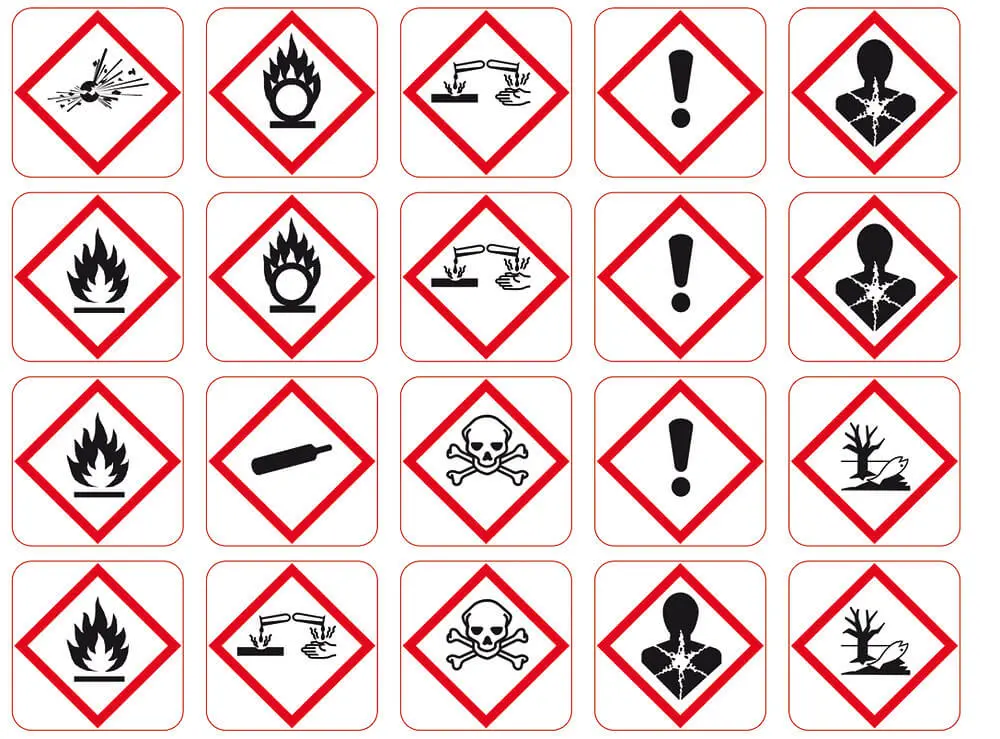
How is GHS Organized?
The GHS or Globally Harmonized System is an international framework designed to standardize the classification and labeling of chemicals based on their hazards. The hazards are grouped into three primary categories: Physical, Health, and Environmental. Each of these primary hazard groups is then further divided into classes, and each class can have further subdivisions known as categories based on the severity or specifics of the hazard.
Health Hazard Classes
- Acute Toxicity: This refers to harmful or fatal effects that result from a single or short-term exposure to a chemical.
- Skin Corrosion/Irritation: This classification is given to chemicals that, upon contact, cause irreversible damage to the skin or cause reversible skin irritation.
- Serious Eye Damage/Eye Irritation: Chemicals that can cause permanent eye damage or temporary eye irritation fall into this class.
- Respiratory or Skin Sensitization: These chemicals can cause allergies or hypersensitivity in the respiratory system or skin after exposure.
- Germ Cell Mutagenicity: Refers to chemicals that can cause genetic defects or increase the risk of birth defects.
- Carcinogenicity: This class is for chemicals that can cause cancer or increase the risk of cancer development.
- Reproductive Toxicity: Chemicals that can negatively affect the reproductive system or harm an unborn child are classified here.
- Specific Target Organ Toxicity – Single Exposure: Refers to chemicals that can cause damage to specific organs following a single exposure.
- Specific Target Organ Toxicity – Repeated Exposure: This class contains chemicals that may cause harm to specific organs upon prolonged or repeated exposure.
- Aspiration Hazard: Chemicals that can cause harm if they enter the lungs, typically by being aspirated during ingestion, are classified under this.
Physical Hazard Classes
- Explosives: Chemicals that can cause explosions.
- Flammable Gases: Gases that can ignite and burn.
- Aerosols: Pressurized containers holding liquids, gases, or solids that can be released as a spray or foam.
- Oxidizing Gases: Gases that can cause or intensify a fire by producing oxygen.
- Gases under Pressure: Gases stored under high pressure can explode if the container is breached.
- Flammable Liquids: Liquids that can ignite easily.
- Flammable Solids: Solids that can easily catch fire.
- Self-reactive Substances and Mixtures: Chemicals that can undergo a strong exothermic reaction without oxygen.
- Pyrophoric Liquids and Solids: Chemicals that can spontaneously ignite when exposed to air.
- Self-heating Substances and Mixtures: These can self-heat and ignite without an ignition source.
- Substances and Mixtures in contact with water emit flammable gases: Chemicals that release flammable gases when they come in contact with water.
- Oxidizing Liquids and Solids: Chemicals that can cause or enhance the combustion of other materials.
- Organic Peroxides: Organic compounds containing the peroxide functional group, which can be highly reactive.
- Corrosive to Metals: Chemicals that can corrode or degrade metals.
Environmental Hazard Classes
- Hazardous to the Aquatic Environment (Acute and Chronic): Chemicals that can cause short-term (acute) or long-term (chronic) harm to aquatic life.
- Hazardous to the Ozone Layer: Chemicals that can contribute to the depletion of the ozone layer in the Earth’s stratosphere, leading to increased UV radiation reaching the Earth.
Each class provides a more precise understanding of the potential risks of a particular chemical, allowing for better hazard communication, safer handling, and more effective emergency response.
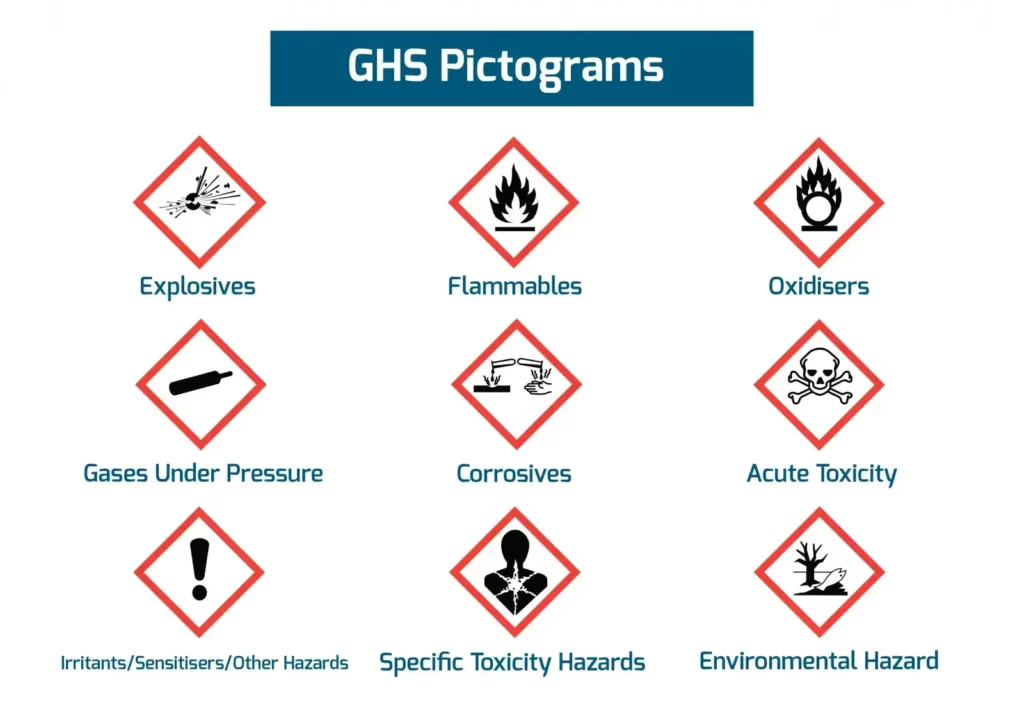
Key Terms In The GHS Vocabulary
- Safety Data Sheet (SDS): An SDS is a standardized document that provides detailed information about the properties, risks, protections, and safety measures for storing, handling, and transporting chemicals. It’s standardized across the GHS system to have 16 sections, each addressing specific aspects like composition, first-aid measures, handling and storage, exposure controls, and more.
- Labels: In the context of GHS, labels are affixed to chemical containers and provide essential, immediate information about the hazards they present. Labels include chemical identity, hazard statements, and standardized elements like symbols, signal words, and possibly precautionary statements. The aim is to give anyone handling the chemical a quick and clear understanding of its risks.
- Hazard Group: This broader classification in GHS divides hazards into three main types – those affecting health, those physical in nature, and those impacting the environment.
- Class: Within the hazard groups are classes, which further detail the types of hazards a chemical can pose. Each class is a distinct division representing a type of hazard. For example, within physical hazards, you have classes like “Gases under Pressure” or “Flammable Liquids.”
- Category: Each class is then divided further into categories. Categories denote the severity or specifics of the hazard within its class. The most hazardous category is usually indicated by the number 1 (or letter A), and the severity typically decreases with ascending numbers.
- Hazard Statement: These are concise, standardized statements defining a chemical’s nature and hazard level. Each category within a class will have its own hazard statement, which then appears on the chemical’s label and SDS.
- Precautionary Statement: These are recommendations provided in a standardized format. They guide users on how to avoid potential hazards, detailing steps for safe handling, storage, and emergency measures.
- Signal Word: GHS uses two main signal words to indicate the severity of hazard – “Danger” for more severe hazards and “Warning” for less severe ones. The idea is to immediately communicate the level of caution when dealing with the chemical.
- Pictogram: Pictograms are graphical images or symbols used on GHS labels and SDSs to quickly and universally convey specific chemical hazards. They are encased in a diamond shape with a red border. Each pictogram is distinct and represents different hazards, from flammability to toxicity.
In essence, these terms and components are crucial in ensuring that the GHS serves its primary function: to communicate chemical hazards effectively and universally, ensuring safety in their use, handling, and transportation.
Conclusion
GHS emerges as a beacon of clarity and uniformity in the intricate labyrinth of global chemical regulations. Representing the Globally Harmonized System of Classification and Labelling of Chemicals, GHS is more than just an acronym; it’s a pivotal step towards a world where the risks and precautions of handling chemicals are universally understood. GHS paves the way for safer practices, reduced costs, and improved regulatory efficiency through its standardized symbols and classifications. Its significance is not just in streamlining trade or industry protocols but in safeguarding the health of individuals and the environment across borders.
As we’ve journeyed through its meanings, symbols, and classifications, one thing remains evident: GHS is a testament to international cooperation’s potential to create systems that transcend boundaries for the collective good. In embracing GHS, we’re not just adopting a system but championing a safer, more informed future.

